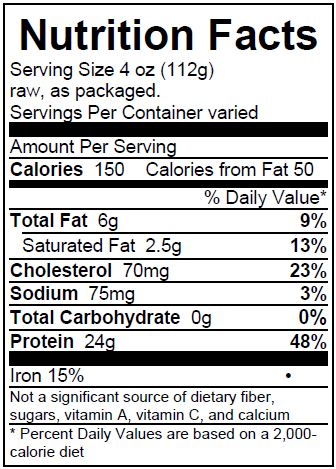|
Meat and poultry provide consumers with a great source of high biological value protein as well as other key nutrients such as iron, thiamine, and zinc. However, they also provide a source of saturated fat and cholesterol, both linked to heart disease. It is possible to enjoy meat and poultry in your diet while also limiting saturated fat and calories but it requires accurate nutrition information. Unfortunately, vague meat labeling laws of the past have only required nutrition labels for products that included added ingredients such as marinades or sauces. The lack of complete information made figuring out the best and worst meat choices while shopping a navigational nightmare. Beginning this month, U.S. Department of Agriculture (USDA) Food Safety and Inspection Service (FSIS) have implemented rules for packaged meat and poultry that will make informed shopping much easier and take the mystery out of meat shopping. Instead of having to remember how much fat is allowed in government definitions of extra lean or lean meat, you can use a nutrition facts label. The label is required on most ground or chopped meat and poultry packages as well as 40 of the most popular whole and raw cuts of meat and poultry. If you don't see the labels on the packages check for nearby store displays to help you make an informed decision at the point of purchase. The label includes the number of calories and grams of total fat and saturated fat as well as protein, cholesterol, sodium and iron levels, just like you find on other packaging. The intent for the labels is to provide consumers with consistent information that allows them to compare calorie and fat content between two cuts of the same meat such as pork chops. It will also allow consumers to compare nutritional information between different types of meat such as ground beef and ground turkey. This will make it easier to translate a lean statement (such 85% lean) into specific numbers and dietary influence. Currently the FSIS does not require nutrition labeling information for non-major cuts of meat or poultry when not ground or chopped. They will be examining the adequacy of the nutrition information provided for the major cuts of meat to assess the need to mandate nutrition information availability for them in the future. So what can you expect to see?  (Photo courtesy of USDA) The label for a package of 95% lean ground beef with details that a 4 ounce serving (raw) contains 150 calories, 6 grams of fat and 70 mg of cholesterol compared to the same size serving of 90% lean ground beef that would offer 200 calories, 11 grams total fat and 75 mg of cholesterol. While the percentage of fat might not help you know to nutritional difference, the nutrition facts label certainly will. Once you've selected your meat of choice, be sure to prepare and present it in a way that keeps it lean and healthy. For example:
Add herbs and spices to enhance the flavor of any meat to compliment your meal. For a Middle Eastern or Southwestern flare, use a spice blend of ground chilies, oregano, ground cumin, and garlic. If Asian is the order of the day, add fresh ginger, star anise, sesame seeds, and hot pepper sauce. You can also take a more savory route and mix Dijon or course grain mustard with marjoram, sage, rosemary, and thyme. Any of these blends with a citrus juice like fresh lemon or lime or mixed with vinegar such as balsamic, red wine or apple cider will create a great tasting and unique flavor without additional fat or carbohydrates to your meal. What do you think about these new labels? Are they helpful and necessary or simply government measures with little benefit? |
More From SparkPeople |






/61536ada-f132-4fd5-bd3a-054cf25b8720.jpg)







